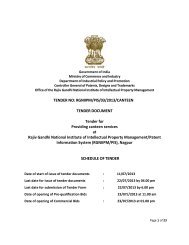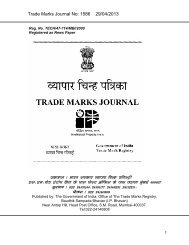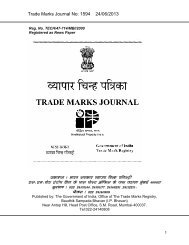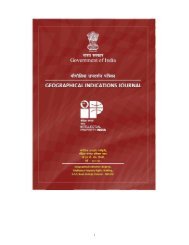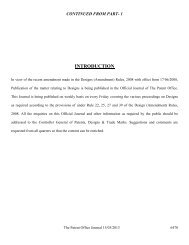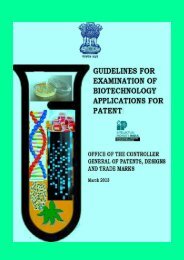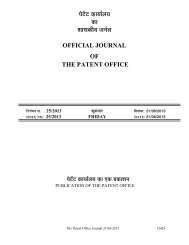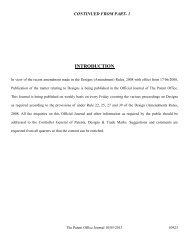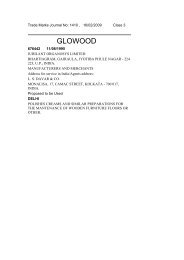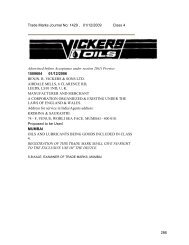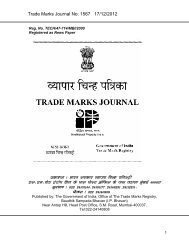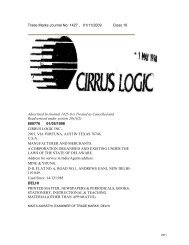- Page 1 and 2:
“ºÎ}Ïà}à qÞººº¸Ÿºº q
- Page 3 and 4:
SUBJECT JURISDICTION SPECIAL NOTICE
- Page 5 and 6:
àœ°Ú±ÂÚ eÀœáœœš œá
- Page 7 and 8:
Special Notice Under the new provis
- Page 9 and 10:
Early Publication Vide Form-9 “Th
- Page 11 and 12:
(12) (19) (22) PATENT APPLICATION P
- Page 13 and 14:
(12) PATENT APPLICATION PUBLICATION
- Page 15 and 16:
(12) PATENT APPLICATION PUBLICATION
- Page 17 and 18:
(12) PATENT APPLICATION PUBLICATION
- Page 19 and 20:
(12) PATENT APPLICATION PUBLICATION
- Page 21 and 22:
(12) PATENT APPLICATION PUBLICATION
- Page 23 and 24:
(12) PATENT APPLICATION PUBLICATION
- Page 25 and 26:
(12) PATENT APPLICATION PUBLICATION
- Page 27 and 28:
(12) PATENT APPLICATION PUBLICATION
- Page 29 and 30:
(12) PATENT APPLICATION PUBLICATION
- Page 31 and 32:
(12) PATENT APPLICATION PUBLICATION
- Page 33 and 34:
(12) PATENT APPLICATION PUBLICATION
- Page 35 and 36:
(12) PATENT APPLICATION PUBLICATION
- Page 37 and 38:
(12) PATENT APPLICATION PUBLICATION
- Page 39 and 40:
(12) PATENT APPLICATION PUBLICATION
- Page 41 and 42:
(12) PATENT APPLICATION PUBLICATION
- Page 43 and 44:
(12) PATENT APPLICATION PUBLICATION
- Page 45 and 46:
(12) PATENT APPLICATION PUBLICATION
- Page 47 and 48:
(12) PATENT APPLICATION PUBLICATION
- Page 49 and 50:
(12) PATENT APPLICATION PUBLICATION
- Page 51 and 52:
(12) PATENT APPLICATION PUBLICATION
- Page 53 and 54:
(12) PATENT APPLICATION PUBLICATION
- Page 55 and 56:
(12) PATENT APPLICATION PUBLICATION
- Page 57 and 58:
(12) PATENT APPLICATION PUBLICATION
- Page 59 and 60:
(12) PATENT APPLICATION PUBLICATION
- Page 61 and 62:
(12) PATENT APPLICATION PUBLICATION
- Page 63 and 64:
(12) PATENT APPLICATION PUBLICATION
- Page 65 and 66:
(12) PATENT APPLICATION PUBLICATION
- Page 67 and 68:
(12) PATENT APPLICATION PUBLICATION
- Page 69 and 70:
(12) PATENT APPLICATION PUBLICATION
- Page 71 and 72:
(12) PATENT APPLICATION PUBLICATION
- Page 73 and 74:
(12) PATENT APPLICATION PUBLICATION
- Page 75 and 76:
(12) PATENT APPLICATION PUBLICATION
- Page 77 and 78:
(12) PATENT APPLICATION PUBLICATION
- Page 79 and 80:
(12) PATENT APPLICATION PUBLICATION
- Page 81 and 82:
(12) PATENT APPLICATION PUBLICATION
- Page 83 and 84:
(12) PATENT APPLICATION PUBLICATION
- Page 85 and 86:
(12) PATENT APPLICATION PUBLICATION
- Page 87 and 88:
(12) PATENT APPLICATION PUBLICATION
- Page 89 and 90:
(12) PATENT APPLICATION PUBLICATION
- Page 91 and 92:
(12) PATENT APPLICATION PUBLICATION
- Page 93 and 94:
(12) PATENT APPLICATION PUBLICATION
- Page 95 and 96:
(12) PATENT APPLICATION PUBLICATION
- Page 97 and 98:
(12) PATENT APPLICATION PUBLICATION
- Page 99 and 100:
(12) PATENT APPLICATION PUBLICATION
- Page 101 and 102:
(12) PATENT APPLICATION PUBLICATION
- Page 103 and 104:
(12) PATENT APPLICATION PUBLICATION
- Page 105 and 106:
(12) PATENT APPLICATION PUBLICATION
- Page 107 and 108:
(12) PATENT APPLICATION PUBLICATION
- Page 109 and 110:
(12) PATENT APPLICATION PUBLICATION
- Page 111 and 112:
(12) PATENT APPLICATION PUBLICATION
- Page 113 and 114:
(12) PATENT APPLICATION PUBLICATION
- Page 115 and 116:
(12) PATENT APPLICATION PUBLICATION
- Page 117 and 118:
(12) PATENT APPLICATION PUBLICATION
- Page 119 and 120:
(12) PATENT APPLICATION PUBLICATION
- Page 121 and 122:
(12) PATENT APPLICATION PUBLICATION
- Page 123 and 124:
(12) PATENT APPLICATION PUBLICATION
- Page 125 and 126:
(12) PATENT APPLICATION PUBLICATION
- Page 127 and 128:
(12) PATENT APPLICATION PUBLICATION
- Page 129 and 130:
(12) PATENT APPLICATION PUBLICATION
- Page 131 and 132:
(12) PATENT APPLICATION PUBLICATION
- Page 133 and 134:
(12) PATENT APPLICATION PUBLICATION
- Page 135 and 136:
(12) PATENT APPLICATION PUBLICATION
- Page 137 and 138:
(12) PATENT APPLICATION PUBLICATION
- Page 139 and 140:
(12) PATENT APPLICATION PUBLICATION
- Page 141 and 142:
(12) PATENT APPLICATION PUBLICATION
- Page 143 and 144:
(12) PATENT APPLICATION PUBLICATION
- Page 145 and 146:
(12) PATENT APPLICATION PUBLICATION
- Page 147 and 148:
(12) PATENT APPLICATION PUBLICATION
- Page 149 and 150:
(12) PATENT APPLICATION PUBLICATION
- Page 151 and 152:
(12) PATENT APPLICATION PUBLICATION
- Page 153 and 154:
(12) PATENT APPLICATION PUBLICATION
- Page 155 and 156:
(12) PATENT APPLICATION PUBLICATION
- Page 157 and 158:
(12) PATENT APPLICATION PUBLICATION
- Page 159 and 160:
(12) PATENT APPLICATION PUBLICATION
- Page 161 and 162:
(12) PATENT APPLICATION PUBLICATION
- Page 163 and 164:
(12) PATENT APPLICATION PUBLICATION
- Page 165 and 166:
(12) PATENT APPLICATION PUBLICATION
- Page 167 and 168:
(12) PATENT APPLICATION PUBLICATION
- Page 169 and 170:
(12) PATENT APPLICATION PUBLICATION
- Page 171 and 172:
(12) PATENT APPLICATION PUBLICATION
- Page 173 and 174:
(12) PATENT APPLICATION PUBLICATION
- Page 175 and 176:
(12) PATENT APPLICATION PUBLICATION
- Page 177 and 178:
(12) PATENT APPLICATION PUBLICATION
- Page 179 and 180:
(12) PATENT APPLICATION PUBLICATION
- Page 181 and 182:
(12) PATENT APPLICATION PUBLICATION
- Page 183 and 184:
(12) PATENT APPLICATION PUBLICATION
- Page 185 and 186:
(12) PATENT APPLICATION PUBLICATION
- Page 187 and 188:
(12) PATENT APPLICATION PUBLICATION
- Page 189 and 190:
(12) PATENT APPLICATION PUBLICATION
- Page 191 and 192:
(12) PATENT APPLICATION PUBLICATION
- Page 193 and 194:
(12) PATENT APPLICATION PUBLICATION
- Page 195 and 196:
(12) PATENT APPLICATION PUBLICATION
- Page 197 and 198:
(12) PATENT APPLICATION PUBLICATION
- Page 199 and 200:
(12) PATENT APPLICATION PUBLICATION
- Page 201 and 202:
(12) PATENT APPLICATION PUBLICATION
- Page 203 and 204:
(12) PATENT APPLICATION PUBLICATION
- Page 205 and 206:
(12) PATENT APPLICATION PUBLICATION
- Page 207 and 208:
(12) PATENT APPLICATION PUBLICATION
- Page 209 and 210:
(12) PATENT APPLICATION PUBLICATION
- Page 211 and 212:
(12) PATENT APPLICATION PUBLICATION
- Page 213 and 214:
(12) PATENT APPLICATION PUBLICATION
- Page 215 and 216:
(12) PATENT APPLICATION PUBLICATION
- Page 217 and 218:
(12) PATENT APPLICATION PUBLICATION
- Page 219 and 220:
(12) PATENT APPLICATION PUBLICATION
- Page 221 and 222:
(12) PATENT APPLICATION PUBLICATION
- Page 223 and 224:
(12) PATENT APPLICATION PUBLICATION
- Page 225 and 226:
(12) PATENT APPLICATION PUBLICATION
- Page 227 and 228:
(12) PATENT APPLICATION PUBLICATION
- Page 229 and 230:
(12) PATENT APPLICATION PUBLICATION
- Page 231 and 232:
(12) PATENT APPLICATION PUBLICATION
- Page 233 and 234:
(12) PATENT APPLICATION PUBLICATION
- Page 235 and 236:
(12) PATENT APPLICATION PUBLICATION
- Page 237 and 238:
(12) PATENT APPLICATION PUBLICATION
- Page 239 and 240:
(12) PATENT APPLICATION PUBLICATION
- Page 241 and 242:
(12) PATENT APPLICATION PUBLICATION
- Page 243 and 244:
(12) PATENT APPLICATION PUBLICATION
- Page 245 and 246:
(12) PATENT APPLICATION PUBLICATION
- Page 247 and 248:
(12) PATENT APPLICATION PUBLICATION
- Page 249 and 250:
(12) PATENT APPLICATION PUBLICATION
- Page 251 and 252:
(12) PATENT APPLICATION PUBLICATION
- Page 253 and 254:
(12) PATENT APPLICATION PUBLICATION
- Page 255 and 256:
(12) PATENT APPLICATION PUBLICATION
- Page 257 and 258:
(12) PATENT APPLICATION PUBLICATION
- Page 259 and 260:
(12) PATENT APPLICATION PUBLICATION
- Page 261 and 262:
(12) PATENT APPLICATION PUBLICATION
- Page 263 and 264:
(12) PATENT APPLICATION PUBLICATION
- Page 265 and 266:
(12) PATENT APPLICATION PUBLICATION
- Page 267 and 268:
(12) PATENT APPLICATION PUBLICATION
- Page 269 and 270:
(12) PATENT APPLICATION PUBLICATION
- Page 271 and 272:
(12) PATENT APPLICATION PUBLICATION
- Page 273 and 274:
(12) PATENT APPLICATION PUBLICATION
- Page 275 and 276:
(12) PATENT APPLICATION PUBLICATION
- Page 277 and 278:
(12) PATENT APPLICATION PUBLICATION
- Page 279 and 280:
(12) PATENT APPLICATION PUBLICATION
- Page 281 and 282:
(12) PATENT APPLICATION PUBLICATION
- Page 283 and 284:
(12) PATENT APPLICATION PUBLICATION
- Page 285 and 286:
(12) PATENT APPLICATION PUBLICATION
- Page 287 and 288:
(12) PATENT APPLICATION PUBLICATION
- Page 289 and 290:
(12) PATENT APPLICATION PUBLICATION
- Page 291 and 292:
(12) PATENT APPLICATION PUBLICATION
- Page 293 and 294:
(12) PATENT APPLICATION PUBLICATION
- Page 295 and 296:
(12) PATENT APPLICATION PUBLICATION
- Page 297 and 298:
(12) PATENT APPLICATION PUBLICATION
- Page 299 and 300:
(12) PATENT APPLICATION PUBLICATION
- Page 301 and 302:
(12) PATENT APPLICATION PUBLICATION
- Page 303 and 304:
(12) PATENT APPLICATION PUBLICATION
- Page 305 and 306:
(12) PATENT APPLICATION PUBLICATION
- Page 307 and 308:
(12) PATENT APPLICATION PUBLICATION
- Page 309 and 310:
(12) PATENT APPLICATION PUBLICATION
- Page 311 and 312: (12) PATENT APPLICATION PUBLICATION
- Page 313 and 314: (12) PATENT APPLICATION PUBLICATION
- Page 315 and 316: (12) PATENT APPLICATION PUBLICATION
- Page 317 and 318: (12) PATENT APPLICATION PUBLICATION
- Page 319 and 320: (12) PATENT APPLICATION PUBLICATION
- Page 321 and 322: (12) PATENT APPLICATION PUBLICATION
- Page 323 and 324: (12) PATENT APPLICATION PUBLICATION
- Page 325 and 326: (12) PATENT APPLICATION PUBLICATION
- Page 327 and 328: (12) PATENT APPLICATION PUBLICATION
- Page 329 and 330: (12) PATENT APPLICATION PUBLICATION
- Page 331 and 332: (12) PATENT APPLICATION PUBLICATION
- Page 333 and 334: (12) PATENT APPLICATION PUBLICATION
- Page 335 and 336: (12) PATENT APPLICATION PUBLICATION
- Page 337 and 338: (12) PATENT APPLICATION PUBLICATION
- Page 339 and 340: (12) PATENT APPLICATION PUBLICATION
- Page 341 and 342: (12) PATENT APPLICATION PUBLICATION
- Page 343 and 344: (12) PATENT APPLICATION PUBLICATION
- Page 345 and 346: (12) PATENT APPLICATION PUBLICATION
- Page 347 and 348: (12) PATENT APPLICATION PUBLICATION
- Page 349 and 350: (12) PATENT APPLICATION PUBLICATION
- Page 351 and 352: (12) PATENT APPLICATION PUBLICATION
- Page 353 and 354: (12) PATENT APPLICATION PUBLICATION
- Page 355 and 356: (12) PATENT APPLICATION PUBLICATION
- Page 357 and 358: (12) PATENT APPLICATION PUBLICATION
- Page 359 and 360: (12) PATENT APPLICATION PUBLICATION
- Page 361: (12) PATENT APPLICATION PUBLICATION
- Page 365 and 366: (12) PATENT APPLICATION PUBLICATION
- Page 367 and 368: (12) PATENT APPLICATION PUBLICATION
- Page 369 and 370: (12) PATENT APPLICATION PUBLICATION
- Page 371 and 372: (12) PATENT APPLICATION PUBLICATION
- Page 373 and 374: (12) PATENT APPLICATION PUBLICATION
- Page 375 and 376: (12) PATENT APPLICATION PUBLICATION
- Page 377 and 378: (12) (19) (22) PATENT APPLICATION P
- Page 379 and 380: (12) (19) (22) PATENT APPLICATION P
- Page 381 and 382: (12) (19) (22) PATENT APPLICATION P
- Page 383 and 384: (12) (19) (22) PATENT APPLICATION P
- Page 385 and 386: (12) (19) (22) PATENT APPLICATION P
- Page 387 and 388: (12) (19) (22) PATENT APPLICATION P
- Page 389 and 390: (12) (19) (22) PATENT APPLICATION P
- Page 391 and 392: (12) (19) (22) PATENT APPLICATION P
- Page 393 and 394: (12) (19) (22) PATENT APPLICATION P
- Page 395 and 396: (12) (19) (22) PATENT APPLICATION P
- Page 397 and 398: (12) (19) (22) PATENT APPLICATION P
- Page 399 and 400: (12) (19) (22) PATENT APPLICATION P
- Page 401 and 402: (12) (19) (22) PATENT APPLICATION P
- Page 403 and 404: (12) (19) (22) PATENT APPLICATION P
- Page 405 and 406: (12) (19) (22) PATENT APPLICATION P
- Page 407 and 408: (12) (19) (22) PATENT APPLICATION P
- Page 409 and 410: (12) (19) (22) PATENT APPLICATION P
- Page 411 and 412: (12) (19) (22) PATENT APPLICATION P
- Page 413 and 414:
(12) (19) (22) PATENT APPLICATION P
- Page 415 and 416:
(12) (19) (22) PATENT APPLICATION P
- Page 417 and 418:
(12) (19) (22) PATENT APPLICATION P
- Page 419 and 420:
(12) (19) (22) PATENT APPLICATION P
- Page 421 and 422:
(12) (19) (22) PATENT APPLICATION P
- Page 423 and 424:
(12) (19) (22) PATENT APPLICATION P
- Page 425 and 426:
(12) (19) (22) PATENT APPLICATION P
- Page 427 and 428:
5 198058 262/MAS/1997 10/2/97 02/12
- Page 429 and 430:
19 198884 62/MAS/2000 25/01/2000 02
- Page 431 and 432:
32 198897 536/MAS/2003 30/06/2003 S
- Page 433 and 434:
48 198924 177/MAS/1997 29/01/1997 0
- Page 435 and 436:
61 198939 411/MAS/1998 2/3/98 KRISH
- Page 437 and 438:
76 199049 1664/MAS/1996 20/09/1996
- Page 439 and 440:
89 199076 1101/MAS/1999 12/11/99 13
- Page 441 and 442:
105 199100 790/MAS/2002 25/10/2002
- Page 443 and 444:
120 199124 694/MAS/1998 2/4/98 NALI
- Page 445 and 446:
138 199155 IN/PCT/2001/01 750/CHE 1
- Page 447 and 448:
PUBLICATION UNDER SECTION 43(2) IN
- Page 449 and 450:
19. 199327 1786/CAL/ 1998 20. 19932
- Page 451:
45. 199359 IN/PCT/ 2001/00879 46. 1




